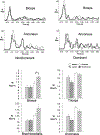Interlimb transfer of load compensation during rapid elbow joint movements
- PMID: 15551087
- PMCID: PMC11102603
- DOI: 10.1007/s00221-004-2055-2
Interlimb transfer of load compensation during rapid elbow joint movements
Abstract
Previous research has shown that training of a novel task can improve subsequent performance in the opposite arm owing to anticipation of the previously learned task conditions. Interestingly, we recently reported preliminary evidence that such transfer might also include modulation of feedback-mediated responses. We now test interlimb transfer of load compensation responses, measured through kinematic and EMG recordings during rapid 20 degrees elbow flexion movements. Two subject groups, LR and RL, each comprising six right-handed subjects, first performed using either the left (LR) or right (RL) arm, followed by opposite arm performance. After 30 trials of consistent performance, five random trials within a background of 50 trials were loaded with a 2-kg mass prior to the "go" signal. We compared load compensation responses for naive performance with those following opposite arm exposure. Under naive conditions, the resulting load compensation responses began about 50 ms following movement onset, and were substantially more effective for the nondominant arm. Opposite arm exposure substantially improved the accuracy of only dominant arm responses. This, however, did not occur through changes in the short latency components of the load compensation response. Instead, changes in muscle activities, associated with interlimb transfer, began some 150 ms following movement onset. We expect that these changes represent transfer in the "volitional" component of the load compensation response. Because the shorter latency response was unaffected by opposite arm exposure, modulation of this component likely requires prior experience with limb specific effectors.
Figures







References
-
- Bennett DJ, Gorassini M, Prochazka A (1994) Catching a ball: contributions of intrinsic muscle stiffness, reflexes, and higher order responses. Can J Physiol Pharmacol 72:525–534 - PubMed
-
- Bizzi E, Dev P, Morasso P, Polit A (1978) Effect of load disturbances during centrally initiated movements. J Neurophysiol 41:542–556 - PubMed
-
- Bock O (1990) Load compensation in human goal-directed arm movements. Behav Brain Res 41:167–177 - PubMed
-
- Bock O (1993) Early stages of load compensation in human aimed arm movements. Behav Brain Res 55:61–68 - PubMed
Publication types
MeSH terms
Grants and funding
LinkOut - more resources
Full Text Sources

